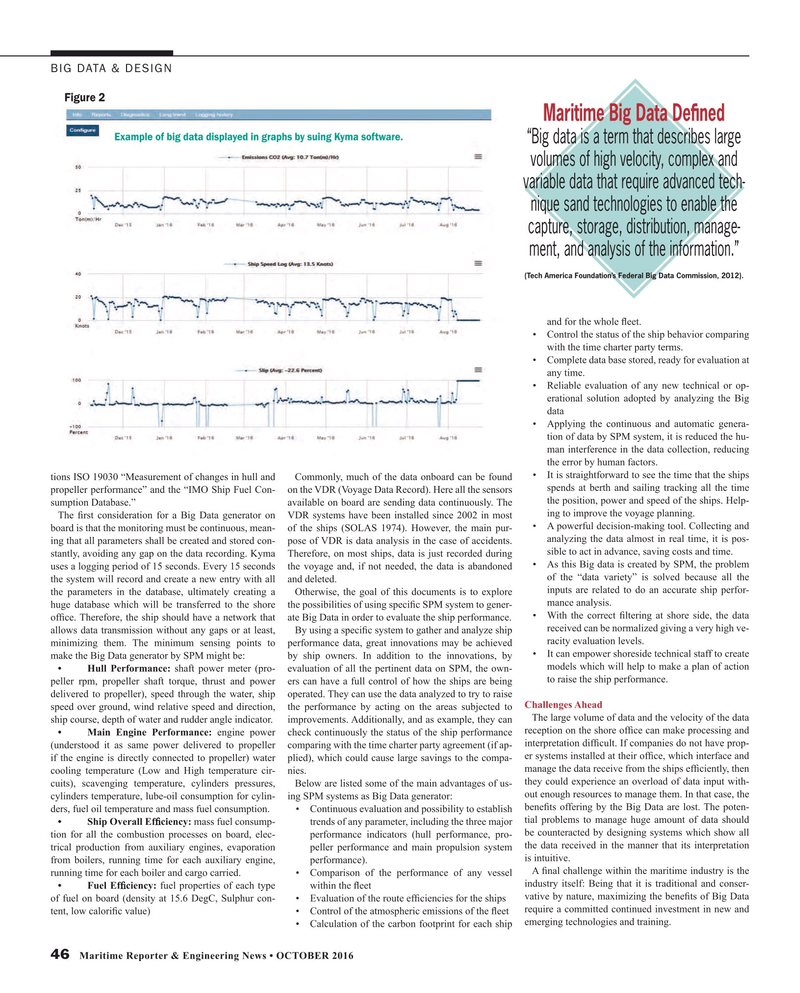
Page 46: of Maritime Reporter Magazine (October 2016)
Marine Design Annual
Read this page in Pdf, Flash or Html5 edition of October 2016 Maritime Reporter Magazine
BIG DATA & DESIGN
Figure 2
Maritime Big Data De? ned
Example of big data displayed in graphs by suing Kyma software.
“Big data is a term that describes large volumes of high velocity, complex and variable data that require advanced tech- nique sand technologies to enable the capture, storage, distribution, manage- ment, and analysis of the information.” (Tech America Foundation’s Federal Big Data Commission, 2012).
and for the whole ? eet.
• Control the status of the ship behavior comparing with the time charter party terms.
• Complete data base stored, ready for evaluation at any time.
• Reliable evaluation of any new technical or op- erational solution adopted by analyzing the Big data • Applying the continuous and automatic genera- tion of data by SPM system, it is reduced the hu- man interference in the data collection, reducing the error by human factors.
• It is straightforward to see the time that the ships tions ISO 19030 “Measurement of changes in hull and Commonly, much of the data onboard can be found spends at berth and sailing tracking all the time propeller performance” and the “IMO Ship Fuel Con- on the VDR (Voyage Data Record). Here all the sensors the position, power and speed of the ships. Help- sumption Database.” available on board are sending data continuously. The ing to improve the voyage planning.
The ? rst consideration for a Big Data generator on VDR systems have been installed since 2002 in most • A powerful decision-making tool. Collecting and board is that the monitoring must be continuous, mean- of the ships (SOLAS 1974). However, the main pur- analyzing the data almost in real time, it is pos- ing that all parameters shall be created and stored con- pose of VDR is data analysis in the case of accidents. sible to act in advance, saving costs and time.
stantly, avoiding any gap on the data recording. Kyma Therefore, on most ships, data is just recorded during • As this Big data is created by SPM, the problem uses a logging period of 15 seconds. Every 15 seconds the voyage and, if not needed, the data is abandoned of the “data variety” is solved because all the the system will record and create a new entry with all and deleted.
inputs are related to do an accurate ship perfor- the parameters in the database, ultimately creating a Otherwise, the goal of this documents is to explore mance analysis.
huge database which will be transferred to the shore the possibilities of using speci? c SPM system to gener- • With the correct ? ltering at shore side, the data of? ce. Therefore, the ship should have a network that ate Big Data in order to evaluate the ship performance.
received can be normalized giving a very high ve- allows data transmission without any gaps or at least, By using a speci? c system to gather and analyze ship racity evaluation levels.
minimizing them. The minimum sensing points to performance data, great innovations may be achieved • It can empower shoreside technical staff to create make the Big Data generator by SPM might be: by ship owners. In addition to the innovations, by models which will help to make a plan of action • Hull Performance: shaft power meter (pro- evaluation of all the pertinent data on SPM, the own- to raise the ship performance.
peller rpm, propeller shaft torque, thrust and power ers can have a full control of how the ships are being delivered to propeller), speed through the water, ship operated. They can use the data analyzed to try to raise speed over ground, wind relative speed and direction, the performance by acting on the areas subjected to Challenges Ahead
The large volume of data and the velocity of the data ship course, depth of water and rudder angle indicator. improvements. Additionally, and as example, they can • Main Engine Performance: engine power check continuously the status of the ship performance reception on the shore of? ce can make processing and interpretation dif? cult. If companies do not have prop- (understood it as same power delivered to propeller comparing with the time charter party agreement (if ap- er systems installed at their of? ce, which interface and if the engine is directly connected to propeller) water plied), which could cause large savings to the compa- manage the data receive from the ships ef? ciently, then cooling temperature (Low and High temperature cir- nies.
they could experience an overload of data input with- cuits), scavenging temperature, cylinders pressures, Below are listed some of the main advantages of us- out enough resources to manage them. In that case, the cylinders temperature, lube-oil consumption for cylin- ing SPM systems as Big Data generator: ders, fuel oil temperature and mass fuel consumption. • Continuous evaluation and possibility to establish bene? ts offering by the Big Data are lost. The poten- • Ship Overall Ef? ciency: mass fuel consump- trends of any parameter, including the three major tial problems to manage huge amount of data should be counteracted by designing systems which show all tion for all the combustion processes on board, elec- performance indicators (hull performance, pro- trical production from auxiliary engines, evaporation peller performance and main propulsion system the data received in the manner that its interpretation is intuitive.
from boilers, running time for each auxiliary engine, performance).
A ? nal challenge within the maritime industry is the running time for each boiler and cargo carried. • Comparison of the performance of any vessel industry itself: Being that it is traditional and conser- • Fuel Ef? ciency: fuel properties of each type within the ? eet vative by nature, maximizing the bene? ts of Big Data of fuel on board (density at 15.6 DegC, Sulphur con- • Evaluation of the route ef? ciencies for the ships require a committed continued investment in new and tent, low calori? c value) • Control of the atmospheric emissions of the ? eet • Calculation of the carbon footprint for each ship emerging technologies and training.
46 Maritime Reporter & Engineering News • OCTOBER 2016
MR #10 (42-49).indd 46 10/5/2016 9:26:44 AM

 45
45

 47
47
